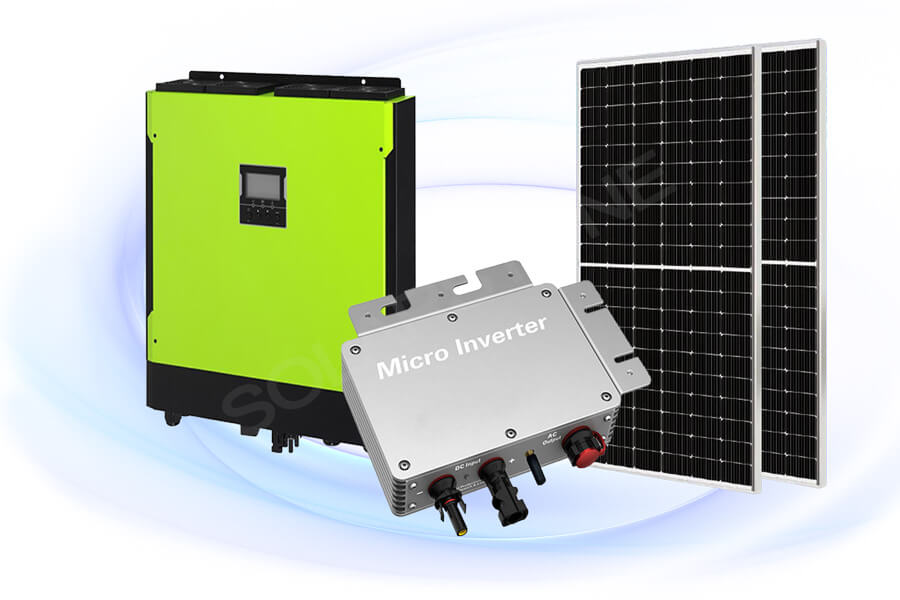Performance parameters of solar inverters
There are many parameters and technical conditions that describe the performance of inverters. Here, we will briefly explain the commonly used technical parameters when evaluating inverters.
1.The operating environment and normal operating conditions of the inverter include an altitude of no more than 1000m and an air temperature of 0~+40 ℃.
2.DC input power supply conditions, input DC voltage fluctuation range: ± 15% of the rated voltage value of the battery pack.
3.The rated output voltage, within the allowable fluctuation range of the specified input DC voltage, represents the rated voltage value that the inverter should be able to output. The stability and accuracy of the output rated voltage value are generally specified as follows:
(1) During steady-state operation, there should be a limit to the range of voltage fluctuations, such as a deviation not exceeding ± 3% or ± 5% of the rated value.
(2) In dynamic situations with sudden load changes or other interference factors, the output voltage deviation should not exceed ± 8% or ± 10% of the rated value.
4.The rated output frequency, the frequency of the inverter’s output AC voltage, should be a relatively stable value, usually 50Hz power frequency. Under normal working conditions, the deviation should be within ± 1%.
5.Rated output current (or rated output capacity) represents the rated output current of the inverter within the specified load power factor range. Some inverter products provide rated output capacity, expressed in VA or kVA. The rated capacity of an inverter is the product of the rated output voltage and the rated output current when the output power factor is 1 (i.e. pure resistive load).
6.Rated output efficiency, the efficiency of an inverter is the ratio of its output power to input power under specified operating conditions, expressed in%. The efficiency of the inverter at rated output capacity is full load efficiency, and the efficiency at 10% of rated output capacity is low load efficiency.
7.The maximum harmonic content of the inverter, the maximum harmonic content of the output voltage of a sine wave inverter under resistive load should be ≤ 10%.
8.The overload capacity of an inverter is the ability of the inverter to output more than the rated current value in a short period of time under specified conditions. The overload capacity of the inverter should meet certain requirements at the specified load power factor.
9.The efficiency of an inverter is the ratio of the output active power of the inverter to the input active power (or DC power) at the rated output voltage, output current, and specified load power factor.
10.Load power factor, which characterizes the ability of an inverter to carry inductive or capacitive loads. Under sine wave conditions, the load power factor is 0.7-0.9 (lagging), with a rated value of 0.9.
11.The asymmetry of the load, under a 10% asymmetric load, the asymmetry of the output voltage of a fixed frequency three-phase inverter should be ≤ 10%.
12.The imbalance of output voltage, under normal working conditions, the three-phase voltage imbalance (ratio of reverse sequence component to positive sequence component) of inverter output should not exceed a specified value, usually expressed in%, such as 5% or 8%.
13.Starting characteristics: Under normal working conditions, the inverter should be able to start normally for 5 consecutive times under full load and no-load operating conditions.
14.Protection function: The inverter should be equipped with short-circuit protection, overcurrent protection, over temperature protection, overvoltage protection, undervoltage protection, and phase loss protection.
Overvoltage protection refers to the implementation of output overvoltage protection measures for inverters without voltage stabilization measures, in order to protect the negative cutoff from damage caused by output overvoltage.
Overcurrent protection refers to the overcurrent protection of the inverter, which should ensure timely action in the event of a short circuit or current exceeding the allowable value in the load, so as to prevent damage from surge currents.
15.Interference and anti-interference, inverters should be able to withstand electromagnetic interference in general environments under specified normal operating conditions. The anti-interference performance and electromagnetic compatibility of the inverter should comply with relevant standards.
16.Inverters that are not frequently operated, monitored, and maintained should be ≤ 95dB; The inverter that is frequently operated, monitored, and maintained should be ≤ 80dB.
17.Display: The inverter should be equipped with data display for parameters such as AC output voltage, output current, and output frequency, as well as signal display for input energized, energized, and faulty states.
18.Communication function, remote communication function allows users to view the operation status and stored data of the machine without having to be on site.
19.When the output voltage of the inverter is sinusoidal, the maximum allowable waveform distortion (or harmonic content) should be specified. Usually expressed as the total waveform distortion of the output voltage, its value should not exceed 5% (single-phase output allows 10%).
20.Starting characteristics, characterizing the ability of the inverter to start with load and its performance during dynamic operation. The inverter should ensure reliable starting under rated load.
21.Noise is generated by components such as transformers, filtering inductors, electromagnetic switches, and fans in power electronic equipment. When the inverter is operating normally, its noise should not exceed 80dB, and the noise of small inverters should not exceed 65dB.







